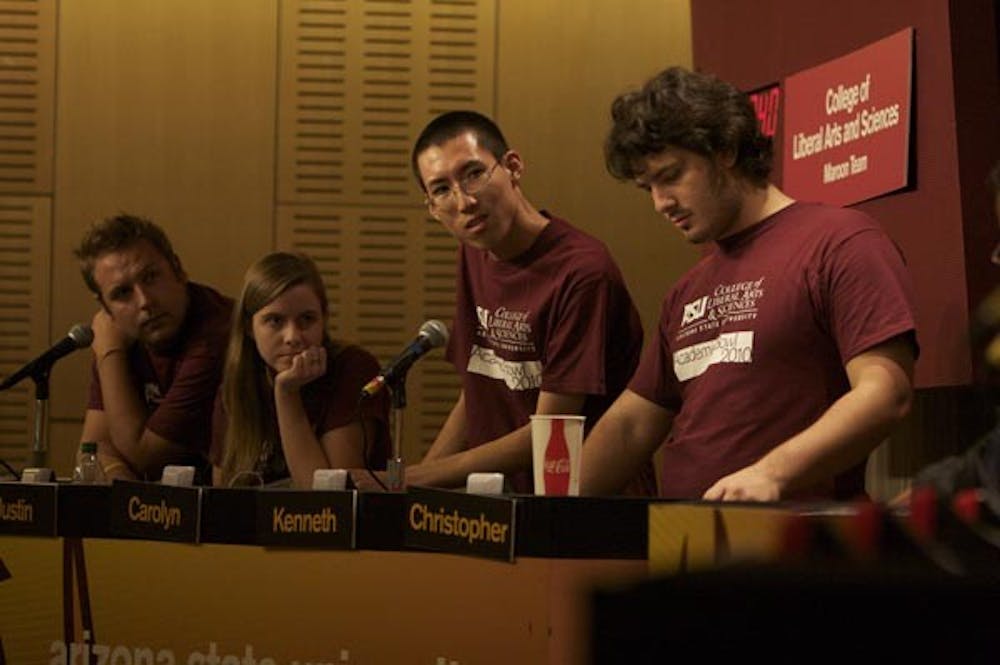Thirteen ASU colleges are being put to the test in the Fifth Annual Academic Bowl.
The College of Liberal Arts and Sciences has been the champion for the past three years, but Thursday night anything could happen when put up against its competitors: Cronkite Gold and W. P. Carey.
The competition started Monday night with 16 different teams and 64 students competing for a spot in the semi-finals answering faculty members’ questions in subjects from history to pop culture.
Four teams will compete Thursday night in the semi-final, and the final two teams will then face off in the final rounds held and televised at the Walter Cronkite School of Journalism and Mass Communication at the KAET- Channel 8 Studios at 7 p.m.
Virgil Renzulli, vice president of public affairs, who organizes the event, said the competition was created to show ASU students’ academic abilities.
“We’d like to give students the chance to show off how smart they are,” Renzulli said.
The competition’s rules are based off of the College Bowl, a national competition that features students from different colleges across the country. Questions are taken from the National Academic Quiz Tournament, which organizes high school and college quiz bowl championships.
There are 16 different teams with four students each plus alternatives, Renzulli said. The teams are divided into four brackets, where two teams compete against each other to advance.
Four teams are in each bracket to begin with.
“Out of each bracket you have one champion and to be a champion you have to win three or four games,” Renzulli said.
There are up to 128 students participating in the beginning of the Academic Bowl, which includes four members per team and alternatives.
The Office of Public Affairs contacts the deans of undergraduate schools and informs them of the Academic Bowl and sees if they’d like to be involved, Renzulli said.
“All the undergraduate schools have the option of fueling [one] team or more,” he said.
Throughout the years, the Academic Bowl had suggestions from students on some changes such as shortening the competition time from 24 minutes to 15 minutes and changing to a double elimination format so teams do not get eliminated after one loss, Renzulli said.
Teams are paired randomly by picking names from a hat.
Elimination rounds were Monday and Tuesday.
Applied computer science freshman Ryan Lane is part of the College of Technology and Innovation team. This is the first year the technology and innovation school has participated in the competition.
“It’s impressive how broad all the questions are but how specific they were at the same time,” Lane said.
Unfortunately, the team lost against the Ira A. Fulton Schools of Engineering Gold Team 290 to 60 on Monday but Lane is rooting for the reigning champions.
“[CLAS] are machines,” Lane said. “They are so good.”
Christopher Chesny, a political science junior, has competed in the Academic Bowl the past two years and is part of the CLAS Maroon team this year. Last year, he competed with the CLAS Gold team.
CLAS and other schools have more than one team because of the size of the school.
“It becomes a little more familiar and personal in that respect because I know the teams that much more intimately,” Chesny said.
Chesny has competed in academic bowls throughout junior high and high school. He specializes in social sciences, history and geography.
Last year, both CLAS teams competed against each other in the final rounds but CLAS Maroon team won with one question.
During preliminaries, schools with two teams do not compete against each other.
CLAS teams practice at least two or three times a week by quizzing each other.
“We tend to be very competitive against each other,” Chesny said. “It’ll probably be one of the best matches of the tournament if we play them again.”
Each participant on the first-place team will receive $5,000 in scholarship money; second-place winners will receive $2,500; and third-place students are awarded $1,250.
“Overall, we … are just very impressed with the quality of the students who participate in it and the preparation that they put into it,” Renzulli said.
Reach the reporter at mpareval@asu.edu





